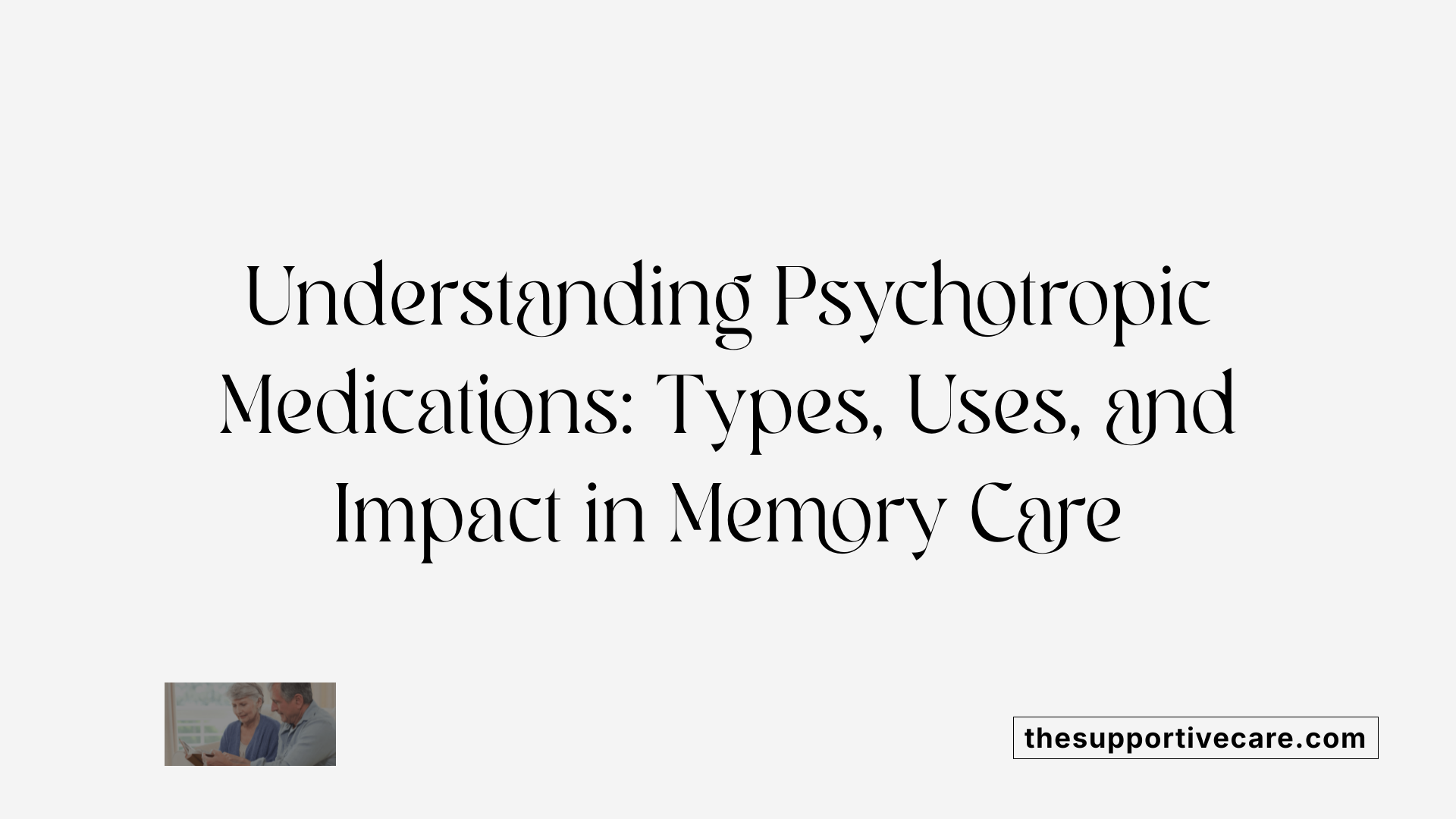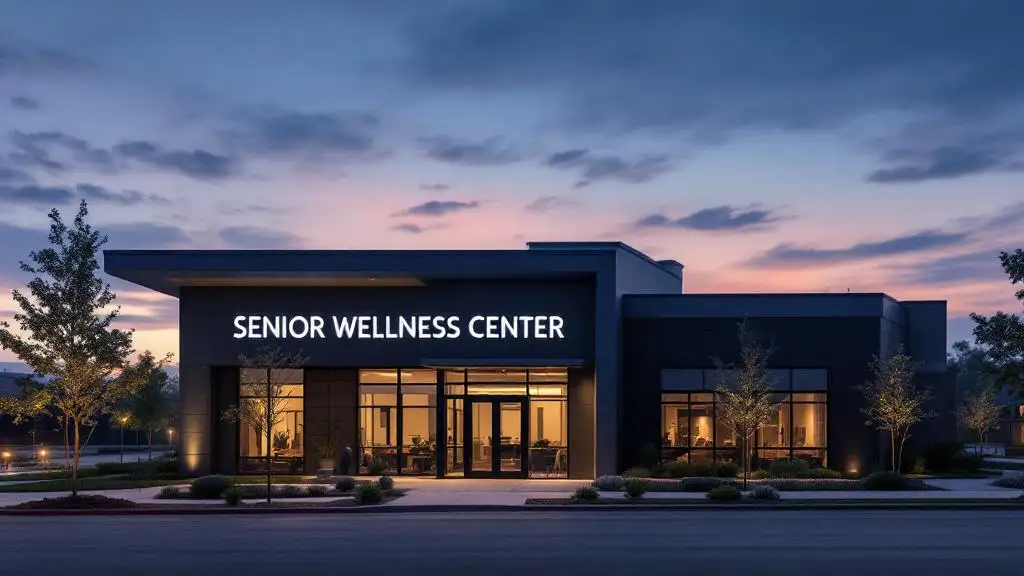Understanding the Intersection of Psychotropic Medication and Memory Care
In memory care settings, the management of psychotropic medications is a crucial component for ensuring patient safety and improving quality of life. Older adults with dementia and related psychiatric symptoms often require these drugs to manage behavioral and mental health challenges. However, the use of psychotropic medications carries inherent risks, particularly in this vulnerable population, making vigilant monitoring essential. This article explores the complexity of psychotropic medication use in memory care facilities, the potential hazards associated with these drugs, and the critical importance of comprehensive, multidisciplinary oversight to optimize treatment outcomes and protect patient wellbeing.
Psychotropic Medications in Memory Care: An Overview

What types of psychotropic drugs are used in memory care?
Psychotropic medications are drugs that affect brain functions related to mental processes and behaviors. In memory care, they are commonly prescribed to manage psychiatric and behavioral symptoms in elderly patients, particularly those with dementia.
Common classes of psychotropic medications
The main categories used in elderly memory care patients include:
- Antidepressants: Especially selective serotonin reuptake inhibitors (SSRIs), which are often preferred due to a safer side effect profile.
- Anxiolytics: Such as benzodiazepines, used to alleviate anxiety but recommended only for short-term use due to risks like oversedation and falls.
- Antipsychotics: Employed to manage agitation, psychosis, and behavioral disturbances associated with dementia. These require careful monitoring given serious risks like extrapyramidal symptoms and increased mortality.
- Anticonvulsants: Sometimes used for mood stabilization or off-label behavioral control.
- Sedatives and hypnotics: Used mainly to treat insomnia or agitation but with caution due to increased fall risks.
Psychiatric and behavioral symptoms treated with psychotropic medications
Psychotropic drugs are prescribed to address a range of symptoms common in memory care patients, including:
- Anxiety
- Depression
- Insomnia
- Agitation and aggression
- Psychosis, such as hallucinations or delusions
These symptoms often arise from underlying dementia-related neuropsychiatric disturbances.
Utilizing psychotropic medications in memory care aims to improve quality of life and care by mitigating distressing symptoms. However, these drugs must be prescribed thoughtfully, considering each patient's vulnerabilities and potential adverse effects.
| Drug Class | Common Examples | Uses in Memory Care |
|---|---|---|
| Antidepressants | SSRIs (e.g., sertraline) | Treat depression, some anxiety, and mood symptoms |
| Anxiolytics | Benzodiazepines | Manage anxiety; short-term use recommended |
| Antipsychotics | Risperidone, olanzapine | Treat agitation, psychosis, aggression |
| Anticonvulsants | Valproate, carbamazepine | Mood stabilization, behavioral control |
| Sedatives | Zolpidem, trazodone | Aid with insomnia and agitation |
Risks and Challenges of Psychotropic Drug Use in the Elderly
Why are older adults more vulnerable to psychotropic medication side effects?
Older adults face increased vulnerability to side effects from psychotropic medications due to physiological changes that occur with aging. These changes impact pharmacokinetics — how the body absorbs, metabolizes, and excretes drugs — as well as pharmacodynamics, which influence how the drugs affect the body. Reduced metabolism and slower excretion lead to drug accumulation, increasing sensitivity to these medications.
Age-related pharmacokinetic and pharmacodynamic changes
As people age, they experience diminished liver and kidney function, altering the metabolism and clearance of psychotropic drugs. This can cause higher drug blood levels for longer periods. Additionally, receptors in the central nervous system become more sensitive, amplifying drug effects. These changes necessitate careful dosage adjustments to avoid toxicity.
Increased risk of adverse drug reactions and hospitalizations
Older adults have a 3.5 times greater risk of hospital admission due to adverse drug reactions compared to younger populations. Psychotropic medications can cause oversedation, confusion, and delirium, which can lead to accidents and hospitalization. Monitoring medication use is crucial to reduce these risks.
Side effects such as hypotension, falls, cognitive impairment
Psychotropic drugs often cause or worsen hypotension, which combined with age-related balance issues and other medications, increases the risk of falls and fractures in elderly patients. Cognitive impairments such as memory loss and delirium are also common side effects, particularly with drugs like benzodiazepines, which should be used cautiously and preferably only short-term in elderly populations.
Maintaining vigilance in dosing, comprehensive assessments, and regular medication reviews can mitigate these risks and improve safety for elderly individuals on psychotropic medications.
Common Adverse Effects of Specific Psychotropic Medication Classes
What are the specific adverse effects associated with common psychotropic medications in the elderly?
Psychotropic medications are frequently used in elderly patients to manage mental health conditions, but they bring distinct risks due to the vulnerability of this population. Understanding the adverse effects of common psychotropic drug classes is crucial for safe prescribing.
Benzodiazepines are widely prescribed for anxiety and insomnia but have significant downsides for older adults. They increase the risk of oversedation, memory impairment, and falls. Because of these risks, benzodiazepines are generally contraindicated for long-term use in elderly patients, and lower or alternative doses are recommended.
Selective serotonin reuptake inhibitors (SSRIs), commonly used antidepressants, are typically preferred in older adults due to having fewer anticholinergic or cardiovascular side effects. Yet, SSRIs still pose risks such as hyponatremia (dangerously low sodium levels) and increased bleeding tendencies, which require vigilance during treatment.
Antipsychotic medications carry some of the most serious risks in this age group. Long-term use can lead to movement disorders including tardive dyskinesia and extrapyramidal symptoms. Neuroleptic malignant syndrome, a potentially fatal reaction, is another severe adverse event. Elderly patients, especially those with dementia, face an increased risk of cerebrovascular events such as stroke and higher mortality rates when taking antipsychotics. Because of these dangers, the FDA has issued black box warnings on all antipsychotics highlighting these increased risks of stroke and death in dementia patients.
Given this, it is essential to apply careful clinical judgment when prescribing these medications to older adults, balancing potential benefits with the elevated risks. Close monitoring and minimizing dosages are important strategies to reduce adverse outcomes.
Regulatory Landscape and Guidelines for Psychotropic Medication Use in Memory Care
What regulations guide psychotropic medication use in nursing homes?
Federal regulations play a crucial role in overseeing psychotropic medication use within memory care settings, particularly nursing homes. A landmark regulation is the Omnibus Budget Reconciliation Act (OBRA) of 1987, paired with subsequent Health Care Financing Administration (HCFA) guidelines. These frameworks emphasize that psychotropic drugs should only be used when medically indicated, prohibiting their use as chemical restraints.
OBRA specifically restricts antipsychotic use to patients with appropriate medical diagnoses, excluding its use solely based on dementia unless clinically justified. It requires healthcare providers to carefully titrate doses, routinely monitor for side effects, and exhaust nonpharmacological interventions before administering these medications.
CMS National Partnership Initiatives
Building on OBRA’s foundation, the Centers for Medicare & Medicaid Services (CMS) National Partnership has initiated efforts to reduce inappropriate antipsychotic prescribing. These initiatives have led to a notable decrease in antipsychotic use in nursing homes from 31% to 22% between 2011 and 2019. The CMS program promotes regular medication reviews, adherence to minimum effective dosages, and close supervision to limit adverse drug events.
Guidelines for Dosing, Monitoring, and Nonpharmacological Interventions
Clinical guidelines recommend a cautious approach to psychotropic medication management in the elderly. Starting with the lowest effective dose, continuous monitoring for adverse effects such as falls, cognitive impairment, or cardiovascular issues is critical. Staff training in behavior management and employing nonpharmacological methods such as sensory enhancement and social engagement are considered first-line strategies.
Medication use must be reassessed at least every three months with adjustments based on individual responses. Nursing facilities are encouraged to develop stringent monitoring protocols, especially for medications with high-risk profiles. These combined regulatory and clinical strategies aim not only to optimize therapeutic outcomes but also to enhance safety and uphold residents' rights in memory care settings.
The Importance of Regular Psychotropic Medication Review and Monitoring

How often should psychotropic medications be reviewed in memory care residents?
Psychotropic medications should be regularly reviewed at least every three months in elderly residents, especially those in memory care settings. This frequent assessment ensures that the treatment remains effective and minimizes the risk of adverse effects. Regular reviews allow healthcare providers to evaluate how well a medication is managing symptoms and identify any emerging side effects early.
Dose adjustments and tapering strategies
Adjusting medication doses is an essential component of managing psychotropic drugs in older adults. Physicians often start with the minimum effective dose and may gradually titrate upwards if necessary. Tapering strategies involve slowly reducing drug dosages to prevent withdrawal symptoms or relapse of psychiatric symptoms. This cautious approach is particularly important for drugs like benzodiazepines, which carry risks such as oversedation and falls when not carefully managed.
Monitoring for side effects and effectiveness
Close observation during medication use is vital because elderly patients are more susceptible to adverse drug reactions. Monitoring includes assessing for common side effects such as drowsiness, memory impairment, hypotension, and increased fall risk, as well as more severe complications like hyponatremia, extrapyramidal symptoms, or increased cerebrovascular events. Comprehensive nursing assessments and the use of medication management software help track these outcomes and support safer prescribing practices.
In summary, a structured psychotropic medication monitoring process involving regular reviews, dose adjustments, and vigilant side effect surveillance is critical to optimize safety and therapeutic benefits in elderly residents receiving these medications.
The Role of Medication Management Technologies in Enhancing Safety
How do medication management technologies support psychotropic drug safety in elderly care?
Pharmacy automation systems have become instrumental in the care of elderly patients receiving psychotropic medications. These advanced systems enhance the accuracy of medication dispensing by minimizing manual errors that could lead to incorrect dosages or wrong medication provision. Automation streamlines the distribution process in nursing homes and other care settings, ensuring that residents receive the correct drug at the prescribed times.
Medication management software complements these systems by offering robust tracking capabilities. This software enables healthcare providers to efficiently monitor medication responses and swiftly identify adverse reactions or side effects, which are critical in vulnerable elderly populations. With timely alerts and reminders, these platforms support regular assessments, which are recommended at least every three months to optimize safety and efficacy.
Together, pharmacy automation and medication management software improve surveillance of psychotropic drug use among elderly clients. They facilitate comprehensive nursing assessments by providing detailed medication histories and enabling real-time updates. This combination reduces the risk of human error and supports adherence to recommended guidelines, such as dose adjustments and the tapering of medications when appropriate.
By integrating these technologies, long-term care facilities can significantly reduce medication errors, enhance patient safety, and promote better health outcomes for elderly residents with psychiatric and behavioral health needs.
Polypharmacy and Its Impact on Psychotropic Medication Risks
What is the significance of polypharmacy in elderly memory care patients?
Polypharmacy, typically defined as the concurrent use of five or more medications, is highly prevalent among elderly individuals, especially those in memory care settings. This extensive use of multiple drugs raises significant concerns due to the heightened risk of adverse drug reactions in this vulnerable group.
Definition and prevalence of polypharmacy
In older adults receiving psychotropic medication, polypharmacy is commonplace. Studies show that many residents in nursing facilities receive several medications simultaneously, often to manage various chronic conditions alongside psychiatric symptoms. This complexity not only complicates care but also increases the potential for negative interactions and side effects.
Increased risk of adverse events
The elderly are particularly susceptible to complications arising from polypharmacy. These include an increased risk of falls, fractures, cognitive impairment, hospital admissions, and even mortality. Older age-related changes in drug absorption, metabolism, and excretion amplify these risks, making oversight critical.
Importance of medication review and rationalization
To mitigate these dangers, regular and systematic medication reviews are essential. Experts recommend reviewing psychotropic and other medications at least every three months to ensure that only necessary drugs are continued at the minimum effective doses. Medication adjustments, including tapering or discontinuation when appropriate, help reduce side effects and improve patient safety.
These reviews should be combined with comprehensive nursing assessments and incorporated into comprehensive monitoring processes that include surveillance for adverse reactions. Advances in medication management software and pharmacy automation have further enhanced the safety of drug administration by improving tracking and reducing errors.
By prioritizing medication rationalization and careful monitoring, healthcare providers can significantly reduce the risks associated with polypharmacy in elderly memory care residents, ultimately improving their quality of life and clinical outcomes.
Nonpharmacological Approaches: A Preferred First Line in Behavioral Management
What non-pharmacological interventions are recommended in memory care behavioral management?
Nonpharmacological interventions are increasingly recognized as essential in managing behavioral symptoms in elderly patients, particularly those with dementia, within memory care settings. These strategies serve as the preferred first-line or adjunct approach to minimize the use of psychotropic medications, which carry significant risks in older adults.
Examples of such interventions include sensory enhancement techniques, which may involve the use of music therapy, aromatherapy, or tactile stimulation to engage and soothe residents. Structured activities, such as scheduled socialization times, cognitive games, or group exercises, help promote interaction and reduce feelings of isolation and agitation.
Staff training plays a crucial role in the success of these approaches. Educating caregivers and nursing staff in behavioral management techniques equips them with the skills to identify triggers, de-escalate challenging behaviors, and effectively communicate with residents. This training improves care quality and helps reduce reliance on medications.
By emphasizing these nonpharmacological methods, care facilities can substantially decrease the prescribing rates of psychotropic drugs. This shift not only reduces the incidence of adverse drug reactions, including falls, sedation, and cognitive impairment, but also enhances residents' overall safety and quality of life.
Benefits of Reducing Psychotropic Drug Use
- Lower risk of oversedation and cognitive decline
- Fewer fall incidents and fractures
- Minimized adverse cardiovascular and neurological effects
- Preservation of residents' mental functioning and awareness
Adopting these interventions aligns with current guidelines advocating for regular medication review, dose minimization, and comprehensive assessments to optimize the safety and efficacy of behavioral management in elderly care.
| Intervention Type | Description | Impact on Behavioral Management |
|---|---|---|
| Sensory Enhancement | Use of music, aromatherapy, tactile stimuli | Calms agitation and improves mood |
| Structured Activities | Scheduled socialization and cognitive games | Promotes interaction and reduces isolation |
| Staff Behavioral Training | Skills in de-escalation and communication | Enables non-drug management of challenging behaviors |
| Medication Reduction | Minimizing or tapering psychotropic drugs | Decreases adverse drug effects and enhances safety |
Addressing Mental Health Issues Within Addiction and Memory Care Programs
How are mental health issues addressed within addiction treatment programs?
Mental health issues in elderly individuals undergoing addiction treatment are addressed through integrated treatment programs. These programs combine therapies targeting both mental health disorders and substance use disorders, recognizing the frequent coexistence of these challenges among older adults.
Multidisciplinary teams—including psychiatrists, psychologists, addiction specialists, nurses, and social workers—collaborate to deliver comprehensive care. This approach ensures that both mental illness symptoms and addiction behaviors are evaluated and managed simultaneously.
Integration of mental health and addiction treatments
Integrated treatments merge psychosocial therapies, medication management, and supportive services. Psychological interventions, such as cognitive-behavioral therapy and supportive counseling, are tailored to meet the unique needs of older adults.
Pharmacologic treatments are carefully prescribed with consideration of age-related changes in drug metabolism and potential adverse reactions. For example, prescribing psychotropic medications in older adults demands close evaluation of risks like falls, cognitive impairment, or drug interactions.
Tailoring therapies for older adults with dual diagnosis
Therapies are customized to accommodate cognitive impairments, comorbidities, and functional limitations typical in the elderly. Nonpharmacological strategies—like behavioral interventions, social engagement, and sensory enhancements—are emphasized to minimize reliance on psychotropic drugs and reduce side effects.
Special attention is paid to polypharmacy risks, requiring regular review and adjustment of medications to prevent adverse drug events.
Ongoing assessment and monitoring
Regular and comprehensive assessments are integral, typically occurring every three months or more frequently if needed. Monitoring focuses on medication efficacy, adverse effects, mental health symptom progression, and substance use patterns.
Use of medication management software and pharmacy automation enhances tracking and safety. This sustained oversight helps optimize therapeutic outcomes, safeguard cognitive function, and improve quality of life for elderly clients facing both mental health and addiction challenges.
Comprehensive Addiction Treatment Services and Their Relevance to Memory Care

What are comprehensive treatment services for substance abuse and addiction?
Comprehensive addiction treatment services provide an integrated care approach that addresses both substance abuse and co-occurring mental health conditions simultaneously. This model combines medical therapies, psychological support, and continuous monitoring to cater to the complex needs of patients, especially older adults.
Integrated approach to substance abuse and mental health
In elderly populations, particularly those in memory care settings, integrated treatment is vital. Substance abuse often coexists with psychiatric symptoms such as anxiety, depression, or dementia-related behavioral issues. Comprehensive services ensure both domains are treated cohesively, reducing the risk of adverse drug reactions and improving overall stability.
Medication-assisted therapies and psychological support
These services often employ medication-assisted therapies (MAT) tailored to the older adult’s unique pharmacokinetic and pharmacodynamic profiles. Psychotropic medications are carefully selected with minimal side effects, and dosing is closely monitored. Psychological interventions, including counseling and behavioral therapies, enhance coping strategies and minimize reliance on medications.
Importance of monitoring to enhance safety in older adults
Regular assessment and monitoring form a cornerstone of comprehensive addiction treatment in memory care. This includes tracking medication efficacy, side effects, and potential interactions, which is crucial due to the heightened vulnerability of elderly patients. Medication management software and frequent re-evaluations help detect adverse effects early and facilitate timely adjustments.
By implementing such integrated, monitored, and patient-centered approaches, comprehensive addiction treatment services contribute significantly to improving quality of life and safety for older adults managing both addiction and mental health issues within memory care environments.
Treatment of Non-Substance Behavioral Addictions and Considerations in Elder Care
What types of addiction treatment services are available beyond substance abuse?
Treatment for non-substance behavioral addictions addresses compulsive behaviors such as gambling, sex, internet, and gaming disorders. These interventions often rely on cognitive-behavioral therapy (CBT), which helps individuals understand and change their behavior patterns. Support groups and family therapy are integral components that provide social reinforcement and assist in rebuilding relationships impacted by addiction.
Therapeutic approaches used
CBT remains the cornerstone of treatment for behavioral addictions, providing tools to manage urges and avoid triggers. Support groups offer peer connection and accountability, essential for sustained recovery. Family interventions educate loved ones about addiction dynamics and support recovery efforts. Tailoring these therapies to individual needs, especially among older adults, enhances engagement and outcomes.
Relevance of tailored treatment in older populations
Older adults face unique challenges such as coexisting medical conditions and cognitive changes that influence treatment planning. Customized approaches accommodate sensory impairments, slower cognitive processing, and possible mobility limitations. Clear communication, slower pacing, and integration of mental health management, including psychotropic medication oversight, are crucial. Addressing these factors promotes effective treatment adherence and quality of life improvement in elderly patients.
Challenges in Consent and Residents’ Rights Related to Psychotropic Medication
What are the issues around informed consent for psychotropic medication in memory care?
Many elderly residents in memory care settings receive psychotropic medications without comprehensive informed consent. Often, decisions about these powerful drugs are made primarily by physicians, with limited input or understanding from the residents themselves. This practice overlooks the residents’ right to be informed about the benefits, risks, and alternatives before starting medication.
Current practices around informed consent
In current care environments, informed consent tends to be underemphasized. Residents with cognitive impairments or dementia are especially vulnerable to being medicated without clear communication or proper consent. Regulations usually allow physicians discretion in prescribing but do not uniformly require residents to be fully involved in the decision-making process.
Legislative proposals for enhancing consent processes
Recognizing these challenges, several policy proposals at both state and federal levels aim to strengthen informed consent procedures. These include mandates for written notices detailing medication benefits and potential side effects, clearer documentation of consent, and more robust oversight to ensure that residents’ rights are respected.
Importance of respecting resident autonomy
Respecting resident autonomy is critical to ethical medication management. Empowering residents with knowledge about their treatment fosters trust, supports their dignity, and may reduce inappropriate or overuse of psychotropic drugs. Enhanced consent practices can contribute to safer, more person-centered care, ultimately improving health outcomes and quality of life in memory care settings.
Impact of Federal Quality Measures on Psychotropic Medication Use Trends

How have federal quality measures influenced psychotropic medication use in nursing homes?
Federal quality measures, such as the CMS star ratings system, have significantly impacted the prescribing patterns of psychotropic medications in nursing homes. While these initiatives aimed to reduce inappropriate medication use and improve resident care, they have also produced unintended consequences.
The introduction of star ratings as a quality benchmark encouraged facilities to focus on reducing reported rates of antipsychotic use. However, this led to an increase in diagnoses such as schizophrenia, allowing nursing homes to justify continued or increased prescriptions of psychotropic drugs under these new diagnostic labels. This strategic diagnostic shift complicates efforts to genuinely curtail overmedication.
As a result, while antipsychotic use decreased from 31% to 22% between 2011 and 2019, other psychotropic medication types, such as anticonvulsants, saw rising use—from 28% to 40%. Consequently, the broader goal of minimizing psychotropic medication use in elderly residents, especially those with dementia, faces ongoing challenges.
This dynamic illustrates how quality measures can unintentionally influence clinical practice beyond their intended scope, requiring continuous monitoring and adaptation of policies to ensure they effectively promote safer prescribing without encouraging diagnostic manipulation.
Balancing Benefits and Risks: The Promise and Pitfalls of Psychotropic Medications

How Can Psychotropic Medications Improve Quality of Life in Older Adults?
Psychotropic medications have a significant role in managing mental health disorders among older adults, including anxiety, depression, and psychosis. When appropriately prescribed, they can enhance quality of life by reducing distressing symptoms, improving mood, and supporting better daily functioning. For example, selective serotonin reuptake inhibitors (SSRIs) are often favored for depression due to their safer profile compared to older antidepressants. Similarly, carefully monitored use of atypical antipsychotics like risperidone may help manage agitation and psychosis related to dementia, potentially easing patient discomfort and caregiver burden.
What Are the Dangers of Inappropriate Psychotropic Medication Use?
Inappropriate use of psychotropic drugs poses serious risks, especially in vulnerable elderly populations. These risks include increased falls, fractures, cognitive decline, and even mortality. For instance, benzodiazepines can cause sedation and memory impairment, while antipsychotics carry warnings of increased stroke and death risk in dementia patients. Overuse or misuse often leads to adverse drug reactions and can reduce an older adult’s mental functioning and awareness of their surroundings. Widespread polypharmacy further complicates the risk landscape, as interactions between multiple medications can intensify harmful side effects.
Why Is Individualized Risk-Benefit Assessment Essential?
Assessing each older adult's unique health status, comorbidities, and medication response is critical to optimizing psychotropic use. Individualized evaluation helps identify when medication benefits outweigh risks and when nonpharmacological strategies might be safer and more effective. Guidelines recommend starting with the lowest effective dose, regular monitoring every three months, and involving residents in informed consent decisions wherever possible. Proper risk-benefit analysis allows healthcare providers to minimize adverse outcomes while maximizing therapeutic gains, ensuring that psychotropic medications serve as tools for support rather than sources of harm.
Ensuring Safe and Effective Psychotropic Medication Use in Memory Care
Psychotropic medication monitoring in memory care settings is indispensable for safeguarding vulnerable elderly patients from serious adverse effects while addressing their complex psychiatric needs. The delicate balance of therapeutic benefit and potential harm mandates rigorous adherence to best practices in prescribing, continuous monitoring, consistent medication review, and prioritization of nonpharmacological interventions. Emphasizing residents’ rights, integrating advanced medication management technologies, and fostering multidisciplinary collaboration further enhance safety and quality of care. By implementing comprehensive oversight, care providers can optimize mental health outcomes and improve quality of life for memory care residents, ultimately transforming psychotropic medication use from a potential liability into a valuable treatment asset.
References
- Psychotropic Medication Use among Older Adults
- Understanding Psychotropic Monitoring in Elderly Care
- Appropriate Use of Psychotropic Medications
- Why Too Many Psychotropic Medications in Nursing ...
- Appropriate Use of Psychotropic Drugs in Nursing Homes
- Mental Health Services in Nursing Homes ...
- Psychotropic Drug Utilization in Long-Term-Care Facilities ...
- Psychotropic medication prescribing in assisted living and ...
- Integrating Mental Health and Addiction Treatment into ...
- Integrated Treatment for Co-Occurring Disorders




































































































